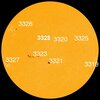SOLAR CYCLE 25 ACTIVITY REPORT JUNE 05_2023
Solar activity has been at low levels for the past 24 hours. The largest solar event of the period was a C8 event observed at 03:45 UTC on June 08 from Region 3323 (S07E20)
There are currently 7 numbered sunspot regions on the solar disk: AR3319, AR3320, AR3321, AR3323, AR3325, AR3326 and new region AR3327
Total number of sunspots has decreased to 110 (40 of these are grouped into 7 active regions) NOAA forecasts for the next 24h: 99% chance for C flares, 35% chance for M flares and 10% chance for X flares.
AR3319 (S20W84 size 220MH) and AR3323 (S05E18 size 320MH) possess a beta-gamma magnetic field that harbors energy to produce M-class flares.
● Auroral Activity
The geomagnetic field has been at quiet to unsettled levels for the past 24 hours. Solar wind speed reached a peak of 388 km/s at 29:16 UTC June 04 Total IMF reached 11 nT at 17:02 UTC on June 04 this means moderately strong magnetic field
Aurora Oval Bz: -1.35 nT South

● Current Conditions at 04: 50 UTC on June 05
▪︎ Geospace quiet (kp 1)
▪︎ Solar wind speed record: 334.2 km/sec (Normal speed)
▪︎ density: 2.31 p/cm³ (low density)
▪︎ Interplanetary Magnetic Field (IMF)
Bt: 7.36 nT (normal nano-Tesla valor)
▪︎ Neutron Counts today: +0.0 % (average)
▪︎ X-ray Solar Flare: C4 at 00:17 UTC
▪︎ Sunspot number: 110 (SN 112 June 04)
▪︎ Spotless Days 2023 total: 0 days (0%)
-
-SpaceWeatherlive..com
-SpaceWeather.com
Solar activity has been at low levels for the past 24 hours. The largest solar event of the period was a C8 event observed at 03:45 UTC on June 08 from Region 3323 (S07E20)
There are currently 7 numbered sunspot regions on the solar disk: AR3319, AR3320, AR3321, AR3323, AR3325, AR3326 and new region AR3327
Total number of sunspots has decreased to 110 (40 of these are grouped into 7 active regions) NOAA forecasts for the next 24h: 99% chance for C flares, 35% chance for M flares and 10% chance for X flares.
AR3319 (S20W84 size 220MH) and AR3323 (S05E18 size 320MH) possess a beta-gamma magnetic field that harbors energy to produce M-class flares.
● Auroral Activity
The geomagnetic field has been at quiet to unsettled levels for the past 24 hours. Solar wind speed reached a peak of 388 km/s at 29:16 UTC June 04 Total IMF reached 11 nT at 17:02 UTC on June 04 this means moderately strong magnetic field
Aurora Oval Bz: -1.35 nT South
● Current Conditions at 04: 50 UTC on June 05
▪︎ Geospace quiet (kp 1)
▪︎ Solar wind speed record: 334.2 km/sec (Normal speed)
▪︎ density: 2.31 p/cm³ (low density)
▪︎ Interplanetary Magnetic Field (IMF)
Bt: 7.36 nT (normal nano-Tesla valor)
▪︎ Neutron Counts today: +0.0 % (average)
▪︎ X-ray Solar Flare: C4 at 00:17 UTC
▪︎ Sunspot number: 110 (SN 112 June 04)
▪︎ Spotless Days 2023 total: 0 days (0%)
-
-SpaceWeatherlive..com
-SpaceWeather.com


